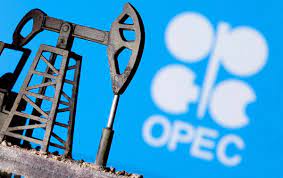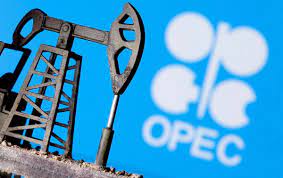
According to forecasts and calculations by Reuters, OPEC will see declining demand for its crude in the first half of 2024, coinciding with a decrease in its worldwide market share to the lowest level since the Covid-19 epidemic due to output cutbacks and member Angola's exit.
According to the pattern, unless OPEC is willing to accept lower oil prices or global oil demand rises, the group will find it difficult to loosen production cuts.
Angola said this month that it would be leaving the Organisation of the Petroleum Exporting Countries (OPEC) in January 2024. Ecuador, Indonesia, and Qatar had already left the group in 2020, 2019 and 2016, respectively.
With Angola out of the picture, the group will only consist of 12 members and produce fewer than 27 million barrels per day (bpd), or less than 27% of the 102 million bpd worldwide supply.
When global demand declined by 15-20% in 2020 due to the pandemic, OPEC's market share last dropped to 27%. Since then, the world's demand has increased to record levels, which means competitors have gained market share from OPEC.
There were no comments on the issue from OPEC.
In the 1970s, the organisation produced approximately half of the world's crude oil before non-OPEC supply sources, such the North Sea, became available.
Later decades saw OPEC's share hover at 30% to 40%, but in recent years, record output growth from competitors like the United States has slowly eaten away at that share.
Figures from the group's monthly reports show that as of November 2023, OPEC's crude oil supply represented 27.4% of the overall market, down from 32–33% in 2017–2018.
Saudi Arabia, Kuwait, Venezuela, Iran, and Iraq formed OPEC in 1960. Angola became a member in 2007. As part of the OPEC+ group, which it formed in 2017, OPEC has collaborated with Russia and other non-members to regulate the market.
In recent years, a few minor producers have joined OPEC: Gabon in 2016, Equatorial Guinea in 2017, and Congo in 2018.
OPEC+ is presently reducing its production by about 6 million barrels per day, so theoretically the group might increase supply in order to compete for market share.
But if the market for crude oil doesn't improve, the price would plummet dramatically.
Russia is among the OPEC+ nations who have stated that the organisation may need to take more action.
There doesn't seem to be much chance for an easing of the cuts in the second quarter, according to data from three widely respected oil forecasters: the International Energy Agency (IEA), the U.S. Energy Information Administration (EIA), and OPEC itself.
Based on a Reuters estimate, the EIA projects a decline in demand for OPEC crude in the second quarter compared to the first.
While OPEC also predicts a decline in demand for its petroleum, it does so at a quicker rate than the other two forecasts. The IEA sees this demand remaining stable.
In the long run, OPEC expects its market share to rise as global demand continues to rise and output declines elsewhere.
According to its most recent World Oil Outlook, as non-OPEC output begins to decline in the early 2030s, the group's overall share of the oil market will rise to 40% in 2045.
(Source:www.reuters.com)
According to the pattern, unless OPEC is willing to accept lower oil prices or global oil demand rises, the group will find it difficult to loosen production cuts.
Angola said this month that it would be leaving the Organisation of the Petroleum Exporting Countries (OPEC) in January 2024. Ecuador, Indonesia, and Qatar had already left the group in 2020, 2019 and 2016, respectively.
With Angola out of the picture, the group will only consist of 12 members and produce fewer than 27 million barrels per day (bpd), or less than 27% of the 102 million bpd worldwide supply.
When global demand declined by 15-20% in 2020 due to the pandemic, OPEC's market share last dropped to 27%. Since then, the world's demand has increased to record levels, which means competitors have gained market share from OPEC.
There were no comments on the issue from OPEC.
In the 1970s, the organisation produced approximately half of the world's crude oil before non-OPEC supply sources, such the North Sea, became available.
Later decades saw OPEC's share hover at 30% to 40%, but in recent years, record output growth from competitors like the United States has slowly eaten away at that share.
Figures from the group's monthly reports show that as of November 2023, OPEC's crude oil supply represented 27.4% of the overall market, down from 32–33% in 2017–2018.
Saudi Arabia, Kuwait, Venezuela, Iran, and Iraq formed OPEC in 1960. Angola became a member in 2007. As part of the OPEC+ group, which it formed in 2017, OPEC has collaborated with Russia and other non-members to regulate the market.
In recent years, a few minor producers have joined OPEC: Gabon in 2016, Equatorial Guinea in 2017, and Congo in 2018.
OPEC+ is presently reducing its production by about 6 million barrels per day, so theoretically the group might increase supply in order to compete for market share.
But if the market for crude oil doesn't improve, the price would plummet dramatically.
Russia is among the OPEC+ nations who have stated that the organisation may need to take more action.
There doesn't seem to be much chance for an easing of the cuts in the second quarter, according to data from three widely respected oil forecasters: the International Energy Agency (IEA), the U.S. Energy Information Administration (EIA), and OPEC itself.
Based on a Reuters estimate, the EIA projects a decline in demand for OPEC crude in the second quarter compared to the first.
While OPEC also predicts a decline in demand for its petroleum, it does so at a quicker rate than the other two forecasts. The IEA sees this demand remaining stable.
In the long run, OPEC expects its market share to rise as global demand continues to rise and output declines elsewhere.
According to its most recent World Oil Outlook, as non-OPEC output begins to decline in the early 2030s, the group's overall share of the oil market will rise to 40% in 2045.
(Source:www.reuters.com)














